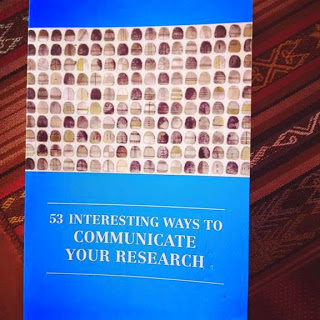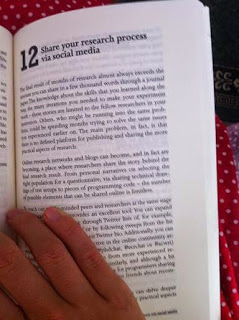53 interesting ways to communicate your research
 Some weeks ago, I laid my hands on my copy of “53 interesting ways to communicate your research”. This book is a collection of essays on communicating your research, covering a wide range of strategies for science communication.
Some weeks ago, I laid my hands on my copy of “53 interesting ways to communicate your research”. This book is a collection of essays on communicating your research, covering a wide range of strategies for science communication.
“53 interesting ways to communicate your research” is not only a very interesting book to browse through and discover some new tips you can implement in communicating your research – it also features an essay by yours truly on sharing your research process through social media.
In total, 37 contributors all provided material for this book, which was edited by Aiofe Brophy Haney and Irenee Daily. The publisher, The Professional and Higher Partnership Ltd, gives a short description as follows:
To maximise the value of your research, you need to communicate it to others. There are many ways to do so: examples include applications and bids, conference presentations, gray literature, journal papers, media (old and new), public talks, and teaching.
This book provides fresh, creative, ways of making the most of these and other opportunities. It provides 53 practical suggestions, each based on ideas tried and tested by the contributors.
Abstract: To be an effective researcher one needs both to conduct high quality research and to communicate it. Research may be communicated to a variety of stakeholders including specialists, researchers in other fields, business, government, the third sector, and the public. A range of methods is available, including presentation, publication, and new and traditional forms of media. 53 practical ideas, rooted in experience, are provided. Overall, the text is designed to help reflective practitioners in professional, scholarly, or scientific research prosper.
Publishers’ foreword:
Until now, our Professional and Higher Education series has focused entirely on teaching and learning. 53 interesting ways to communicate your research signals our decision to extend the series to cover other aspects of work in post-compulsory education.
While broadening the series, our intention is to preserve its original values. Each book in the series provides constructive ideas that are rooted in practice and readily applicable.
Overall this book is designed as a supportive resource for researchers working in professional, academic, or scientific settings.
If you want to get a peek at the tips and hints covered in the book, you can check out the (quite positive) review over at the Thesis Whisperer, with a Top 10 of things she learned from reading this book.
Besides the book, there is also a follow-up project Researchology, a blog in which the different techniques from the book will be put into practice.

